7-5. The ancient
mammoth bone had
39 notches around its rim and 49 (plus a fraction → ca ¼ ?) notches
incised on the bottom. This could indicate there was no
change from one system of looking at the stars to another - instead they
could work perfectly well together, viz. as complementary
views:
 |
*10 |
 |
*39
|
 |
|
Ea6-10 (188) |
Ea6-20 |
(291 - 54 = 237) |
SCHEDIR
|
SEPT 25 (*188) |
*227 |
|
*242 |
*188 + *64 = *252 |
*291 = *227
+ *64 |
|
50 |
There were 39 glyphs placed both in
line Ea6 and in line Ea7:
|
ALCYONE (*56 → 2
* 28) |
a1 |
32 |
32 |
|
BETELGEUZE (*88) |
a2 |
33 |
65 |
|
NAOS (*121
→
11 * 11) |
a3 |
35 |
100 |
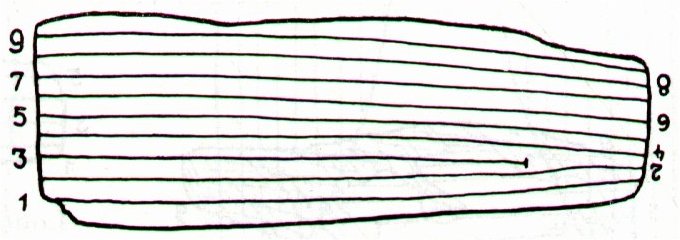 |
|
TANIA AUSTRALIS
(*156 → 2 * 78) |
a4 |
36 |
78 |
|
PORRIMA (*191) |
a5 |
42 |
|
NUSAKAN (*156 +
*78) |
a6 |
39 |
156 |
|
NASH (*273 → 3 * 91) |
a7 |
39 |
Therefore the current right
ascension position corresponding to Ea7-20 should be 39 glyphs
after Ea6-20, viz. at *252 + *39 = *291.
To get there we have first to move
past the remaining 19 days in line Ea6 as counted from Ea6-20:
|
May 27 |
28 (148, *68) |
29 |
30 (300 / 2) |
 |
 |
 |
 |
|
Ea6-17 |
Ea6-18 |
Ea6-19 |
Ea6-20 (198) |
|
tagata mau - moa |
te honu paka |
moa |
kua kau |
|
Paka.
1. Dry; to become dry (of things);
pakapaka, to dry out. Te paka is also the
name of the moss-covered areas, between the small lakes
of volcano Rano Kau, through which one can pass
without getting one's feet wet. 2. To go, to depart;
he-paka-mai, to come; he-oho, he-paka, they
go away. 3. To become calm (of the sea): ku-paka-á te
tai. Pakahera, skull, shell, cranium;
pakahera puoko tagata, human skull; pakahera
pikea, shell of crab or crayfish. Gutu pakapaka,
scabbed lips. Hau paka, fibres of the hauhau
tree, which were first soaked in water, then dried to
produce a strong thread. Moa gao verapaka,
chicken with bald neck. Ariki Paka, certain
collateral descendents of Hotu Matu'a, who
exercised religious functions. Vanaga. 1. Crust, scab,
scurf; paka rerere, cancer; pakapaka,
crust, scabby. 2. Calm, still. 3. Intensive; vera
paka, scorching hot; marego paka, bald;
nunu paka, thin. 4. To arrive, to come. 5. To be
eager. 6. To absorb. 7. Shin T. Pakahera,
calabash, shell, jug. Pakahia, to clot, curdle,
coagulate. Pakapaka, dry, arid, scorching hot,
cooked too much, a desert, to fade away, to roast, a
cake, active; toto pakapaka, coagulated blood;
hakapakapaka, to dry, to broil, to toast.
Pakahera pikea, shell of crab or crayfish.
Churchill.
Kau. 1. To move one's feet
(walking or swimming); ana oho koe, ana kau i te
va'e, ka rava a me'e mo kai, if you go and move your
feet, you'll get something to eat; kakau (or also
kaukau), move yourself swimming. 2. To spread (of
plants): ku-kau-áte kumara, the sweet potatoes
have spread, have grown a lot. 3. To swarm, to mill
around (of people): ku-kau-á te gagata i mu'a i tou
hare, there's a crowd of people milling about in
front of your house. 4. To flood (of water after the
rain): ku-kau-á te vai haho, the water has
flooded out (of a container such as a taheta). 5.
To increase, to multiply: ku-kau-á te moa, the
chickens have multiplied. 6. Wide, large: Rano Kau, 'Wide
Crater' (name of the volcano in the southwest corner of
the island). 7. Expression of admiration: kau-ké-ké!
how big! hare kau-kéké! what a big house!
tagata hakari kau-kéké! what a stout man! Vanaga. To
bathe, to swim; hakakau, to make to swim. P Pau.,
Mgv., Mq.: kau, to swim. Ta.: áu, id.
Kauhaga, swimming. Churchill. The
stem kau does not appear independently in any
language of Polynesian proper. For tree and for timber
we have the composite lakau
in various stages of transformation. But kau will
also be found as an initial
component of various tree names. It is in Viti that we
first find it in free existence. In Melanesia this form
is rare. It occurs as kau in Efaté, Sesake, Epi,
Nguna, and perhaps may be preserved in Aneityum; as
gau in Marina; as au in Motu and somewhere in
the Solomon islands. The triplicity of the Efaté forms [kasu,
kas, kau] suggests a possible transition.
Kasu and kas are easy to be correlated,
kasu and kau less easy. They might be linked
by the assumption of a parent form kahu, from
which each might derive. This would appear in modern
Samoan as kau; but I have found it the rule that
even the mildest aspirate in Proto-Samoan becoming
extinct in modern Samoan is yet retained as aspiration
in Nuclear Polynesia and as th in Viti, none of
which mutations is found on this record. Churchill 2 |
|
REVERSED NAKSHATRA → CLOSE TO THE FULL MOON: |
|
Nov 25 (329, *249) |
26 |
27 |
28 |
|
"Oct
15 (288 → 12 * 24) |
16 |
17 |
18 |
|
SEPT 22 (*185) |
23 |
24 |
25 |
|
Al Kalb-16 (The Heart)
/
Jyeshtha-18 (Eldest) /
ANA-MUA-1 (Entrance pillar)
ANTARES = α Scorpii
(249.1),
MARFIK (Elbow) = λ Ophiuchi,
φ Ophiuchi (249.5), ω Ophiuchi (249.8) |
γ Apodis (250.1), σ Herculis (250.3), θ Tr. Austr.
(250.6), τ Scorpii (250.7) |
HAN = ζ Ophiuchi
(251.0) |
ζ Herculis, η Tr. Austr. (252.1), η Herculis, β Apodis
(252.5) |
|
... Antares, visible
in the morning sky of December-January, came to stand
for summer heat; hence the saying, 'Rehua cooks
(ripens) all fruit' [hakatupu].
The generally accepted version of the Rehua myth,
according to Best, is that Rehua had two wives,
the stars on either side of Antares. One was
Ruhi-te-rangi or Pekehawani, the
personification of summer languor (ruhi), the
other Whaka-onge-kai, She-who-makes-food-scarce
before the new crops can be harvested ...

... Antares is
visible in the sky all night around May 31 of each year,
when the star is at opposition to the Sun. At this time,
Antares rises at dusk and sets at dawn. For
approximately two to three weeks on either side of
November 30, Antares is not visible in the night sky,
because it is near conjunction with the Sun; this period
of invisibility is longer in the Northern Hemisphere
than in the Southern Hemisphere, since the star's
declination is significantly south of the celestial
equator ...
Rerehu,
Burning; a Maori name for Antares related to Rehua.
Rerehu presided over the sixth month
November-December in Stowell's enumeration, while
Tregear associated Rerehu with the ninth month,
February-March. Rehu is found in the Hawaiian
star and month name Welehu, the Tuamotuan
Herehu, and in the Rehu, Varehu, and
Avarahu of the Society Islands ... Herehu
is a Tuamotuan star whose name suggests the Maori
Rerehu and Rehua and the Marquesan Ehua,
all names for Antares. The Hawaiian equivalent lehu
is found in the star name Lehuakona,
Lehua-of-the-south. Rehu is seen in such month
names a Serehu of Tongareva, Welehu of
Hawaii, and Rehu and Varehu of the Society
Islands ... Waerehu is listed as a Maori star and
was a name for Antares among the Moriori as well as for
the month of January.
Hu. 1. Breaking of wind. T Mgv.,
uu, to break wind. Mq., Ta.: hu, id. 2.
Whistling of the wind, to blow, tempest, high wind. P
Pau.: huga, a hurricane. Churchill. Mgv.: hu,
to burst, to crackle, to snap. Ha.: hu, a noise.
Churchill.
Rehu.
1. Dust. P Mgv.: rehu, a cinder, coal,
ashes. Mq.: éhuahi, ashes. Ta.: rehu,
ashes, soot, any powder. 2. To omit, to forget, to
faint. Rehurehu, to omit, omission, lost to
sight. Hakarehu, to surprise. Rehua,
unintelligible. Churchill. Mgv.: rehurehu, from
early dawn to mid morning. Ta.: rehurehu,
twilight. Mq.: ehuehu, id. Churchill. Mq.: ehu,
to fall in bits. Ma.: rehu, to split off in
chips. Ehua, Ehuo, a large constellation.
Ma.: rehua, a star or planet, probably Jupiter.
Churchill. |
|
INVISIBLY CLOSE TO
THE SUN: |
|
No star listed (67) |
Rohini-4 (The Red One)
/
Pidnu-sha-Shame-4 (Furrow of Heaven)
/
ANA-MURI-2
(Rear pillar - at the foot of which was the place for
tattooing)
ALDEBARAN = α Tauri
(68.2),
THEEMIN = υ² Eridani
(68.5) |
No star listed (69) |
No star listed (70) |
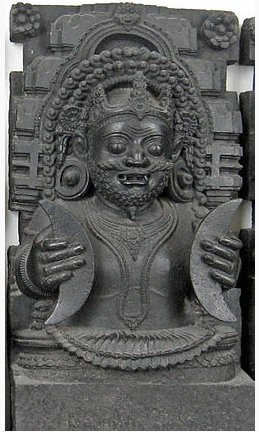
... In Hindu
tradition, Rahu is a cut-off head of an asura, that
swallows the sun or the moon causing eclipses. He is depicted in
art as a serpent with no body riding a chariot drawn by eight
[8] black horses ... According to legend, during the Samudra
manthan, the asura Rahu drank some of the divine
nectar. Sun and moon realized it and they alerted Mohini
(the female avatar of Vishnu). Before the nectar could
pass his throat, Mohini cut off his head. The head,
however, remained immortal. It is believed that this immortal
head occasionally swallows the sun or the moon, causing
eclipses. Then, the sun or moon passes through the opening at
the neck, ending the eclipse
... |
|
May 31 |
June 1 (100 + 52) |
→
Terminalia |
3 (100 + 54) |
4
→ Febr 25 (420) |
 |
 |
 |
 |
 |
|
Ea6-21 |
Ea6-22 (200) |
Ea6-23 |
Ea6-24 |
Ea6-25 |
|
moa |
moe te goe |
moa |
moe te goe |
moa |
|
Goe. Milky Way. Vanaga.
... This
Snake-river of sparkling dust, the stream of the
abyss on high through which it runs, the golden cord
of the heaven-god ... connected alike with the hill
of the Sun-god and with the passage of ghosts, is
the Milky
Way ... |
|
REVERSED
NAKSHATRA → CLOSE TO THE FULL MOON: |
|
Nov 29 (333) |
30 |
Dec 1 (*255) |
2 (4 * 84) |
3 |
|
"Oct 19 |
20 |
21 (*214) |
22 (295) |
23 |
|
ATRIA = α Tr. Austr.
(253.9) |
Tail-6 (Tiger)
WEI (Tail) = ε Scorpii,
η Arae (254.3),
DENEBAKRAB = μ Scorpii
(254.7) |
ι Ophiuchi (255.3),
GRAFIAS = ζ Scorpii (255.4)
*214.0 = *255.4 - *41.4 |
κ Ophiuchi (256.2), ζ Arae (256.5), ε Arae (256.8),
CUJAM (Club) = ε Herculi
(256.9) |
No star listed (257) |
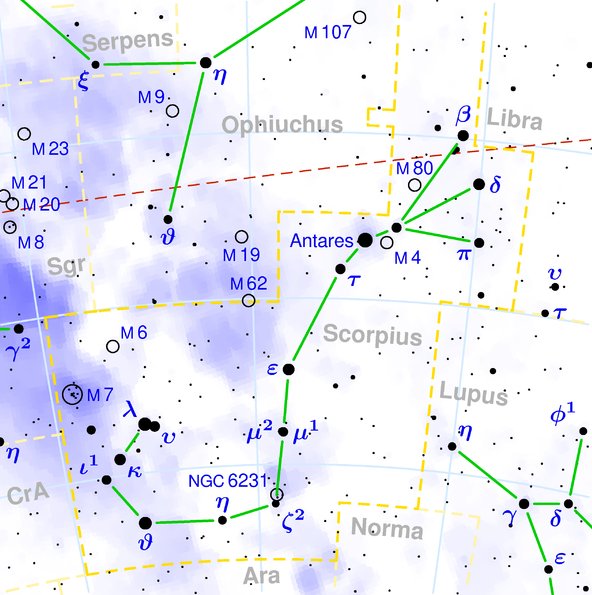
 |
|
SEPT 26 |
27 |
28 (*191) |
29 |
30 |
|
INVISIBLY CLOSE TO
THE SUN: |
|
TABIT =
π³
Orionis
(71.7),
π²
Orionis (71.9) |
π4
Orionis (72.1),
ο¹
Orionis (72.4),
π5
Orionis (72.8)
*31.0 = *72.4 - *41.4 |
π¹
Orionis (73.0),
ο²
Orionis (73.4),
HASSALEH =
ι
Aurigae
(73.6),
π6
Orionis (73.9)
*32.0 = *73.4 - *41.4 |
ALMAAZ (The Male Goat)
=
ε
Aurigae
(74.7),
HAEDUS I =
ζ
Aurigae
(74.8) |
HAEDUS II = η Aurigae
(75.9) |
 |
|
June 5 (156 → 2 * 78) |
6 |
7 (*78) |
8 |
 |
 |
 |
 |
|
Ea6-26 |
Ea6-27 |
Ea6-28 |
Ea6-29 (207) |
|
manu rere |
moa |
kua oro |
moa |
|
Oro.
1. To flit
in the air (of a bird), turning and flying up and
down. 2. To file, to scratch, to scrub, to grind, to
sharpen; ka-oro te kumara, grind the sweet
potatoes; ka-oro te hoe, sharpen the knife.
Orooro, to rub, to polish, to shine. Vanaga.
Oroina,
to choke on a fish bone.
Orooro,
to whet, to sharpen (horo).
Churchill. |
|
REVERSED
NAKSHATRA → CLOSE TO THE FULL MOON: |
|
Dec 4 |
5 |
6 (*260) |
7 (341 → 300 +
41) |
|
"Oct 24 |
25 |
26 |
27 (*220) |
|
17h
(*258.7)
ARRAKIS = μ Draconis
(258.7) |
Mula-19 (The Root)
SABIK (The Preceding One) =
η
Ophiuchi
(259.7),
η
Scorpii (259.9) |
NODUS I =
ζ
Draconis
(260.0),
π
Herculis (260.7),
RAS ALGETHI =
α
Herculis
(260.8) |
SARIN =
δ
Herculis
(261.0),
ο
Ophiuchi (261.4)
*220.0 = *261.4 - *41.4
ALRISHA (α Piscium) |
 |
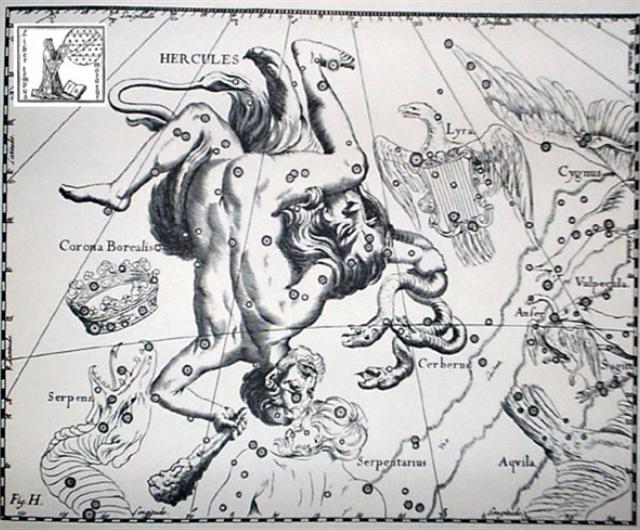 |
|
OCT 1 |
2 |
3 (*196) |
4 |
|
INVISIBLY CLOSE TO
THE SUN: |
|
5h (*76.1)
ε
Leporis (76.0),
CURSA (Footstool) =
β
Eridani (76.4),
λ
Eridani (76.7)
*35.0 = *76.4 - *41.4 |
μ Aurigae, μ Leporis (77.6) |
ĸ Leporis (78.0),
RIGEL (Foot) =
β
Orionis
(78.1),
Flaming Star = IC405
(78.2),
CAPELLA (Mother Goat) =
α
Aurigae (78.4),
ο
Columbae,
τ
Orionis (78.8)
*37.0 = *78.4 - *41.4
THUBAN (α Draconis) |
λ Aurigae (79.0), λ Leporis (79.6), ρ Aurigae (79.7) |
 |
|
June 9 (2 *
80) |
10 |
11 |
12 |
13 |
14 (*85) |
 |
 |
 |
 |
 |
 |
|
Ea6-30 (2 * 104) |
Ea6-31 |
Ea6-32 |
Ea6-33 |
Ea6-34 |
Ea6-35 |
|
manu kake rua |
marama 2 |
tagata uru - vai |
hokohuki - kiore |
hokohuki - kiore |
|
Kake. Kakea, to come near, to embark. P Pau.:
kake, to climb, to ascend. Mgv.: kake,
the arrival of shoals of spawning fish. Mq.: kake,
to climb up a valley. Ta.: ae, to climb, to
ascend. Churchill. Mgv.: kake, to strike on
an ocean reef. Ta.: ae, to strand. Churchill.
Sa.: a'e, upward, to go up; sa'e, to
elevate one leg, as in the act of falling in a club
match; 'a'e, to ascend, to rise. To.: hake,
upward, to ascend. Fu.: ake, up, to ascend;
sake, ro raise the leg at one in derision or
mockery; kake, to climb, to ascend. Niuē:
hake, up, going up. Uvea: ake, up;
kake, to go up. Ma.: ake, upward; kake,
to climb, to ascend. Mq.: ake, on high,
upward; kake, to ascend. Mgv.: ake,
upward. Bukabuka: ake, up. Ta.: ae,
up, to go up, to ascend, to climb. Ha.: ae,
to raise, to lift up, to mount. Fotuna:
no-jikijiake, to lift up; no-tukake, to
stand upright. Nukuoro: kake, to go up.
Nuguria: kake, up; hanage, northwest.
Rapanui: kake a, to go abroad. Vi.: thake,
upward; thaketa, to dig or lift up. Churchill
2. |
|
June 15 (2 * 83) |
16 |
17 (2 * 108 - 2 *
24) |
18 (*89) |
 |
 |
 |
 |
|
Ea6-36 (2 * 107) |
Ea6-37 |
Ea6-38 (216) |
Ea6-39 |
|
tagata hakareva |
ka reva te ika |
e atu te ika |
ko te ika |
|
Reva.
To hang
down; flag, banner. Revareva, 1. To be
hanging vertically; to detach oneself from the
background of the landscape, such a person standing
on top of a hill: ku-revareva-á te tagata i ruga
i te maúga. 2. To cast itself, to project itself
(of shadows); revareva-á te kohu o te miro i te
maeha o te mahina, the shadow of the tree casts
itself in the light of the moon. 3. Uvula. Vanaga.
To hang, to suspend, flag, banner; hakareva,
to hang up; hakarereva, to hang up, to
balance; hakarevareva, to wave. T Pau.:
reva, a flag; fakarevareva, to hang up,
to suspend. Mgv.: reva, a flag, a signal.
Mq.: éva, to hang up, to be suspended, to
wave a signal. Ta.: reva, a flag, banner;
revareva, to wave. The germ sense is that of
being suspended ... any light object hung up in the
island air under the steady tradewind will flutter;
therefore the specification involved in the wave
sense is no more than normal observation. Churchill.
Mgv.: 1. A plant. Ta.: reva, id. Mq.: eva,
id. Sa.: leva, id. Ma.: rewa-rewa, id.
2. To cross, to pass across quickly; revaga,
departure. Ta.: reva, to go away, to depart.
Ma.: reva, to get under way. Churchill. Ta.:
The firmanent, atmosphere. Ha.: lewa, the
upper regions of the air, atmosphere, the visible
heavens. Churchill.
Atu.
Particle of meaning opposite to that of mai;
it refers to the second or third person, expressing
movement away: ka-avai-atu, give it to him:
he-oho-atu au, I am going there, after you;
i-oho-atu-era, when I had gone there. Vanaga.
1. a. Directive, of motion from the speaker. b.
Somewhat expressive of the comparative degree. 2.
Pupil; hakaatu, proof; hare hakaatuga,
schoolhouse, class. 3. (hakaatu), to presage.
4. (hakaatu), mark, object. Churchill. |
 |
64 |
 |
|
Ea5-16 (152)
|
Ea6-39
(217) |
|
ALSEIPH (*24.5) |
ξ Columbae (*88.5) |
|
The place of ξ Columbae coincided with the right
ascension line at
Betelgeuze, which culminated (at 21h) in January 29,
i.e. 10 days after Rigel.
|
Betelgeuze |
(80 + RA / 24h * 365¼) |
225 |
Day of
culmination |
138 |
|
June 17 (168) |
Jan 29 (394) |
|
365 days |
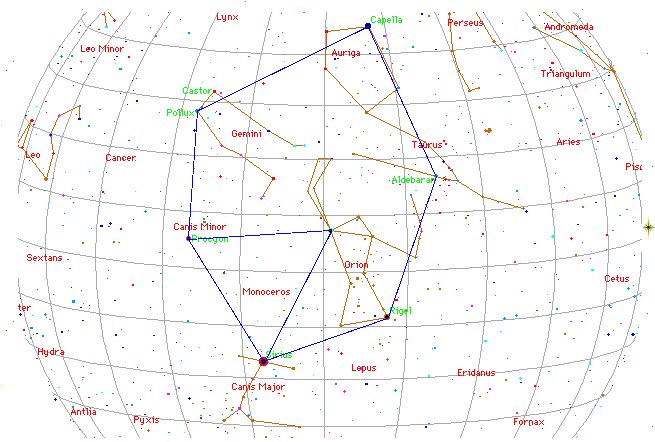
The Winter Hexagon surrounding Betelgeuze is brightly visible in the
winter nights north of the equator, while simultaneously
south of the equator the hexagon would be harder to see
due to the high trajectory of the Sun in summer.
Therefore, for people looking up at the stars on Easter
Island the Orion constellation would be easier to observe
by following the trajectory of the face of the Moon:
... In view of the almost universal
prevalence of the Pleiades year throughout the
Polynesian area it is surprising to find that in the
South Island and certain parts of the North Island of
New Zealand and in the neighboring Chatham Islands, the
year began with the new Moon after the yearly morning
rising, not of the Pleiades, but of the star Rigel in
Orion ...
|
June 19 |
20 (*91) |
Solstice |
22 (173) |
23 (2 * 111 -
48) |
St John's Day |
 |
 |
 |
 |
 |
 |
|
Ea7-1 |
Ea7-2 |
Ea7-3 (2 *
110) |
Ea7-4 |
Ea7-5 |
Ea7-6 |
|
Te hokohuki |
te ua |
ka huki
raua |
ka huki ia |
ko
raua |
ka hukihuki |
|
Hoko. 1. To jump;
to rock or swing in rhythm with
the chants in festivals, as was the ancient
custom; an ancient
dance. He to'o mai e te hoa manu i te mamari ki toona rima, he ma'u,
he hoko, the 'bird master' receives the egg
in his hand and carries it, dancing. 2. Number
prefix: 'in a group of...': hokotahi,
alone; hokorua, in a group of two (also companion, e
hakarere te kai mo toou hokorua, leave some
food for my companion); hakatoru, in a
group of three, etc.; hokohía, in a group
of how many? Hokohía ana oho koe ki te rano?
With how many people will you go to the volcano?
Vanaga. 1. To traffic, to trade, to buy, to
ransom (hoò); hoòa te kaiga, to
buy land. 2. To sport, to play. Churchill. Move
the body to and fro with the rythm of a song.
Barthel.
Huki.
1. Pole attached to the poop from which the
fishing-net is suspended: huki kupega. 2.
Digging stick. 3. To set vertically, to
stand (vt.). 4. Huki á te mahina, said of
the new moon when both its horns have become
visible. Vanaga. 1. To post up, to publish. 2.
To cut the throat (uki). Mq.: Small
sticks which close up the ridge of a house. Ha.:
hui, the small uniting sticks in a
thatched house. Churchill. Standing upright.
Barthel. M. Spit for roasting. Te Huki, a
constellation. Makemson. Hukihuki. 1.
Colic. 2. To transpierce, a pricking. 3. To sink
to the bottom. Churchill.
Ma.: The deity Rongo: Ka ki
atu a Tu raua ko Roko ki a Rehua. |
|
REVERSED
NAKSHATRA → CLOSE TO THE FULL MOON: |
|
Dec 19 (*273) |
20 |
Solstice |
22 (173 +
183) |
23 (357) |
Christmas Eve |
The great moai statues of Easter Island were connected
with ure:
... Métraux quotes a Rapa Nui legend
in which carvers from Hotu Iti (eastern sector) journeyed
to the western sector to seek the advice of a master carver.
They were perplexed about how to resolve the difficult problem
of carving the statue neck. He advised them to seek the answer
by viewing their own bodies. They did so, and discovered that
the model for the statue neck was the penis (ure)
...
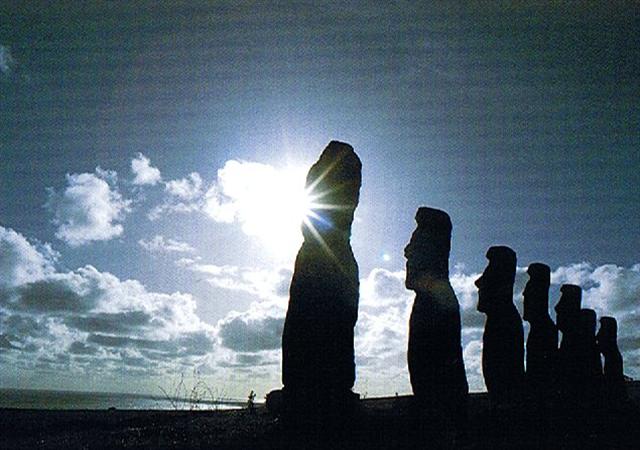
The rule we have discovered earlier which states that there should be
'6 days for loading the canoe'
is followed here above too, because then (after St John's
Day in June 24) something else was
beginning, viz. a 16-day long sequence:

|
June 25 |
26 |
27 |
|
Dec 25 |
26 |
27 |
 |
 |
 |
|
Ea7-7 (224) |
Ea7-8 |
Ea7-9 |
|
kua rere te pepe |
te henua - te rima |
hakamoe |
 |
 |
 |
|
Ea7-10 |
Ea7-11 |
Ea7-12 |
|
kua tere te pepe |
te henua - te rima |
moea |
 |
 |
 |
|
Ea7-13 |
Ea7-14 |
Ea7-15 (232) |
|
te pepe |
te henua - te rima |
moe |
|
Pepe. 1. A sketch. 2. Bench, chair,
couch, seat, sofa, saddle; here pepe, mau
pepe, to saddle; noho pepe, a tabouret.
Pepepepe, bedstead. 3. Pau.: butterfly. Ta.:
pepe, id. Mq.: pepe, id. Sa.: pepe,
id. Ma.: pepe, a moth; pepererau, fin,
Mgv.: pererau, wing. Ta.: pereraru,
id. Ma.: parirau, id. Harepepe, kelp.
Here pepe, to saddle. Churchill. Sa.: pepe,
a butterfly, a moth, to flutter about. Nukuoro, Fu.,
Niuē, Uvea, Fotuna,
Nuguria, Ta., Mq.: pepe,
a butterfly. Ma.: pepe,
a grup, a moth; pepepepe,
a butterfly; pepeatua,
a species of butterfly. To.: bebe,
a butterfly. Vi.: mbèbè,
a butterfly. Rotumā: pep,
id. Churchill 2. Mq.: Pepepepe, low,
flat. Ha.: pepepe, id. Churchill. |
 |
 |
|
Ea7-16 |
Ea7-17 (2 * 117) |
|
inoino |
moe |
 |
 |
|
Ea7-18 |
Ea7-19 (48 + 188) |
|
te inoino |
moe |
 |
 |
 |
|
Ea7-20 (*227 → π) |
Ea7-21 |
Ea7-22 (239) |
|
te maitaki |
kua hakarava ki te huaga - 2 |
... The Taoist philosopher Zhuangzi once had
a dream of being a butterfly flying without care about humanity,
however when he woke up and realized it was just a dream, he
thought to himself 'Was I before a man who dreamt about being a
butterfly, or am I now a butterfly who dreams about being a
man?' In some old cultures, butterflies also symbolize rebirth
into a new life after being inside a cocoon for a period of time
...
A butterfly (pepe) was natural to think of because of the
outline of Orion:
"The dominating constellation [in winter] is Orion whose stars
form a recognizable rectangle with the middle occupied by three
bright stars in a row. The whole group is reminiscent of a
butterfly with wings extended." (Klepešta)
The central part of an insect is its body which is
divided into 3 segments.

|





























